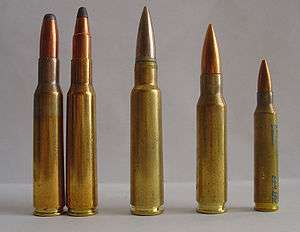7×57mm Mauser
| 7×57mm | ||||||||||||||||||||
|---|---|---|---|---|---|---|---|---|---|---|---|---|---|---|---|---|---|---|---|---|
|
| ||||||||||||||||||||
| Type | Rifle | |||||||||||||||||||
| Place of origin |
| |||||||||||||||||||
| Service history | ||||||||||||||||||||
| Used by |
Spain Dominican Republic Colombia Mexico Brazil Chile Kingdom of Serbia Venezuela Boers | |||||||||||||||||||
| Wars |
First Rif War Spanish–American War Second Boer War Macedonian Struggle Balkan Wars First World War Spanish Civil War other conflicts | |||||||||||||||||||
| Production history | ||||||||||||||||||||
| Designer | Paul Mauser | |||||||||||||||||||
| Designed | 1892 | |||||||||||||||||||
| Variants | 7×57mmR (rimmed) | |||||||||||||||||||
| Specifications | ||||||||||||||||||||
| Parent case | none | |||||||||||||||||||
| Case type | Rimless, bottleneck | |||||||||||||||||||
| Bullet diameter | 7.24 mm (0.285 in) | |||||||||||||||||||
| Neck diameter | 8.25 mm (0.325 in) | |||||||||||||||||||
| Shoulder diameter | 10.92 mm (0.430 in) | |||||||||||||||||||
| Base diameter | 12.01 mm (0.473 in) | |||||||||||||||||||
| Rim diameter | 12.10 mm (0.476 in) | |||||||||||||||||||
| Rim thickness | 1.15 mm (0.045 in) | |||||||||||||||||||
| Case length | 57.00 mm (2.244 in) | |||||||||||||||||||
| Overall length | 78.00 mm (3.071 in) | |||||||||||||||||||
| Case capacity | 3.90 cm3 (60.2 gr H2O) | |||||||||||||||||||
| Rifling twist | 220 mm (1 in 8.66 in) | |||||||||||||||||||
| Primer type | Large rifle | |||||||||||||||||||
| Maximum pressure (C.I.P.) | 390.00 MPa (56,565 psi) | |||||||||||||||||||
| Maximum pressure (SAAMI) | 351.63 MPa (51,000 psi) | |||||||||||||||||||
| Ballistic performance | ||||||||||||||||||||
| ||||||||||||||||||||
| Source(s): RWS / RUAG Ammotech[1] | ||||||||||||||||||||
The 7×57mm cartridge, also known as the 7mm Mauser, 7×57mm Mauser, 7mm Spanish Mauser in the USA and .275 Rigby in the United Kingdom is a first-generation smokeless powder rimless bottlenecked rifle cartridge. It was developed by Paul Mauser of the Mauser company in 1892 and adopted as a military cartridge by Spain in 1893.[2] It was subsequently adopted by several other countries as the standard military cartridge. It is recognised as a milestone in modern cartridge design, and although now obsolete as a military cartridge, it remains in widespread international use as a sporting round. The 7×57mm has been described as "a ballistician's delight". Many sporting rifles in this calibre were made by British riflemakers, among whom John Rigby was prominent; and, catering for the British preference for calibres to be designated in inches, Rigby called this chambering the .275 bore after the measurement of a 7 mm rifle's bore across the lands.[2]
History
Paul Mauser visited the Kingdom of Spain in 1892 after delivery of trial rifles in 1891 and brought with him a new rifle designed to use a new cartridge of 7 mm caliber which he had developed for use with the than new smokeless propellant introduced as Poudre B in the 1886 pattern 8mm Lebel that started a military rifle ammunition revolution. This new rifle featured a new internal box magazine where the cartridges were stored in a staggered column. The Spaniards were so impressed with this new arm and its new 7×57mm Mauser cartridge that they not only placed an order with Mauser but also awarded him the Grand Cross of the Spanish Military Order of Merit, the highest decoration Mauser ever received.[3]
Cartridge dimensions
The 7×57mm cartridge has 3.90 ml (60 grains H2O) cartridge case capacity. The exterior shape of the case was designed to promote reliable case feeding and extraction in bolt action rifles and machine guns alike, under extreme conditions.

7×57mm maximum C.I.P. cartridge dimensions. All sizes in millimeters (mm).
Americans would define the shoulder angle at alpha/2 ≈ 20.55 degrees. The common rifling twist rate for this cartridge is 220 mm (1 in 8.66 in), 4 grooves, diameter of lands = 6.98 mm (0.275 in), diameter of grooves = 7.24 mm (0.285 in), land width = 3.90 mm (0.154 in) and the primer type is large rifle.
European 7 mm cartridges all have 7.24 mm (0.285 in) grooves diameter. American 7 mm cartridges have 7.21 mm (0.284 in) grooves diameter.
According to the official C.I.P. (Commission Internationale Permanente pour l'Epreuve des Armes à Feu Portatives) rulings the 7×57mm case can handle up to 390.00 MPa (56,565 psi) Pmax piezo pressure. In C.I.P. regulated countries every rifle cartridge combo has to be proofed at 125% of this maximum C.I.P. pressure to certify for sale to consumers.[4]
The SAAMI Maximum Average Pressure (MAP) for this cartridge is 51,000 psi (351.63 MPa) piezo pressure or 46,000 CUP.[5][6] Although this lower specification is in deference to the purportedly weaker actions of the older Mauser 93 and 95 rifles which are still in circulation,[6] this concern is misplaced, as the original ammunition developed for, and issued with, the M93 Spanish Mauser produced an average pressure of 50,370 CUP in those rifles.[7][8]
7×57mmR (rimmed)
A rimmed cartridge was developed from the 7×57mm shortly after its introduction for use in break-action rifles and combination guns. A rimmed cartridge greatly simplifies the issues of designing an extractor, particularly in a combination gun or "drilling" which must also be designed to extract rimmed shotgun shells. While various modern break-action and single-shot rifle and pistol designs have been developed that can reliably extract rimless cartridges, most of these date from the 1970s or later. While the external dimensions of the two versions are nearly identical other than the rim, there are differences in the internal design. In particular, the cartridge web, the area immediately above the rim on the rimmed version or the rebate on the rimless version, is thinner in the rimmed case, and some authorities recommend limiting the rimmed cartridge to 41,000 CUP because of this.[9]

7×57mmR cartridge dimensions. All sizes in millimeters (mm).[10]
Sporting round

The ballistics of the 7×57mm became popular with deer and plains game hunters. The relatively flat trajectory and manageable recoil ensured its place as a sportsman's cartridge. The 7×57mm can offer very good penetrating ability due to a fast twist rate that enables it to fire long, heavy bullets with a high sectional density. This made it popular in Africa, where it was used on animals up to and including elephants, for which it was particularly favoured by noted ivory hunter W.D.M. "Karamojo" Bell, who shot about 800 African Elephants with 1893 pattern 7×57mm military ball ammunition using Rigby Mauser 98 rifles, when most ivory hunters were using larger-caliber rifles.[11] Bell selected the cartridge for moderate recoil, and used 11.2-gram (172.8 gr) long round-nosed military full metal jacket bullets for reliable penetration. Bell sectioned an elephant skull to determine the size and location of the brain, and used careful aim to ensure bullet placement in the brain.[2]
The 7×57mm was also the favored cartridge of Eleanor O'Connor, wife of famous hunter and author Jack O'Connor. Eleanor accompanied her husband on multiple hunting expeditions all over the world, killing small and large game with the 7×57mm. Though not as popular today, the 7×57mm is still produced by most major ammunition manufacturers and many modern rifles are available chambered for the cartridge.
The 7×57mm round was also used by the Indian hunter and conservationist Jim Corbett to put down the infamous man-eating Leopard of Rudraprayag besides a few other Man-Eaters of Kumaon. Corbett's writings mention using the .275 Mauser-Rigby rifle with attached torch to despatch the leopard on a dark summer night in May 1926. For man-eating tigers, Corbett preferred a double-barrelled .450/400 Nitro Express rifle but retained the Mauser-Rigby as a backup weapon.
Able to handle a wide range of projectile weights, easy to reload, mild in recoil and accurate, the 7×57 offers a lot. This is well known to hunters, through both personal experience and the reading of a well-documented track record extending back more than 100 years. Rifle Metallic Silhouette shooters are also discovering the versatility and competitiveness of the 7×57.[12]
Military use
The military of the Kingdom of Spain adopted a new Mauser Spanish Model 1893 rifle design in 1893. It was chambered for the also new 7×57mm Mauser cartridge. The original cartridge featured a long, 11.2-gram (173 gr) round-nose, full-metal-jacketed bullet with a muzzle velocity of about 700 m/s (2,300 ft/s) with 2,744 J (2,024 ft·lbf) muzzle energy from a 740 mm (29.1 in) barreled rifle.[2] For the late 19th century, these ballistics were impressive, and the loading provided a fairly flat trajectory combined with excellent penetration. At the same time, it exhibited relatively modest free recoil. That was a combination of attributes that made it popular with both soldiers and sportsmen alike.
The qualities of the 7×57mm as a military round were shown in the Spanish–American War of 1898. At the commencement of the American assault on the strategic Cuban city of Santiago, 750 Spanish troops defended positions on San Juan and Kettle Hills. The attacking force numbered approximately 6,600 American soldiers, most of them armed with then-new smokeless-powder Krag–Jørgensen rifle in .30-40 Krag caliber,[13] and supported by artillery and Gatling gun fire. Though the assault was successful, the Americans soon realized that they had suffered more than 1,400 casualties, nearly 20 per cent of their forces. A U.S. board of investigation later concluded that the casualties were primarily due to the superior firepower of the Spanish Model 1893 Mauser rifles.
During the Second Boer War in South Africa, British authorities were obliged to re-evaluate rifle and ammunition design and tactics after facing Boer sharpshooters and snipers armed with Mauser Model 1895 rifles firing 7×57mm rounds with withering effectiveness, easily outranging the .303 British cartridge as regards accurate long-range fire.[14] The .303 British cartridge at that time was still using cordite propellant, in contrast to the Mauser's higher-performance ballistite type smokeless powder.[15] The British modernized the .303 British cartridge to the Mark 7 variant with a "spitzer" bullet, and updated their rifle to the Short Magazine Lee–Enfield No. 1 Mk III.
Military ammunition
The oldest 1893 pattern military ball ammunition was loaded with a 11.2-gram (172.8 gr) long round-nosed bullet fired at a muzzle velocity of 670 m/s (2,198 ft/s) with 2,514 J (1,854 ft·lbf) muzzle energy from a 589 mm (23.2 in) long barrel. It had a maximum range of 3,250 m (3,554 yd).[16] In 1893 this ballistic performance made it the high-performance service cartridge champion of its day when compared to other 1893 pattern smokeless-powder cartridges such as the 8mm Lebel, .303 British, and 8×50mmR Mannlicher.
In 1913, following the lead of French and German Army commands in developing the spitzer or pointed-tip bullet shape, the Spanish ordnance authorities issued a redesigned 7×57mm cartridge with a spitzer bullet (7mm Cartucho para Mauser Tipo S).[17] It was loaded with a 9-gram (138.9 gr) spitzer bullet fired at a muzzle velocity of 850 m/s (2,789 ft/s) with 3,251 J (2,398 ft·lbf) muzzle energy from a 589 mm (23.2 in) long barrel. It had a maximum range of 3,700 m (4,046 yd).[16] The new spitzer bullet style was partially responsible for the cartridge's improved performance as it significantly reduced air drag within normal combat ranges and withstood higher accelerations in the barrel.
After that military ball ammunition loaded with a 10.5-gram (162.0 gr) spitzer bullet fired at a muzzle velocity of 750 m/s (2,461 ft/s) with 2,953 J (2,178 ft·lbf) muzzle energy from a 589 mm (23.2 in) long barrel became available. Besides a pointed nose this projectile also had a boat tail to reduce drag. It had a maximum range of 5,000 m (5,468 yd).[16]
Military users
At one time, the 7×57mm Mauser cartridge saw widespread military use. It was used by:
 Bolivia[18][19]
Bolivia[18][19] Chile[18][19][20][21]
Chile[18][19][20][21].svg.png) China[18][19][21]
China[18][19][21].svg.png) Costa Rica[18][19]
Costa Rica[18][19].svg.png) El Salvador[18]
El Salvador[18] Honduras[18][19]
Honduras[18][19] Iran[18]
Iran[18].svg.png) Mexico[18][19][21]
Mexico[18][19][21] Orange Free State[18][19][20][22][21]
Orange Free State[18][19][20][22][21].svg.png) Paraguay[18]
Paraguay[18].svg.png) Kingdom of Serbia[23]
Kingdom of Serbia[23] Spain[24]
Spain[24] South African Republic[18][19][20][22][21]
South African Republic[18][19][20][22][21] Uruguay[18][21]
Uruguay[18][21] Venezuela[25]
Venezuela[25]
Chambered service weapons
Mauser Model 1893, Mauser Model 1895 and Mauser Model 1899, FN Mauser M1924/30, Remington Rolling Block, Venezuelan FN Model 1949, Hotchkiss Model 1922 machine gun, Madsen machine gun.
Use as a parent case
The .257 Roberts uses the 7×57mm Mauser as its parent cartridge.
Wildcats
The 7×57mm Mauser is also used as the parent case for a host of modified variants that are not officially registered with or sanctioned by C.I.P. or its American equivalent, SAAMI. These cartridges are known as wildcat cartridges.
The US wildcat cartridge developer P.O. Ackley developed several 7×57mm Mauser based wildcat cartridges.[26]
The 7×57mm Mauser Ackley Improved is an alternate version of the 7×57mm Mauser cartridge with 40 degree shoulder. This wildcat was designed to be easily made by rechambering existing firearms, and fire forming the ammunition to decrease body taper and increase shoulder angle, resulting in a higher case capacity. Dies for this wildcat chambering are readily available.
The .228 Ackley Magnum is also based on the 7×57mm Mauser cartridge but is also necked down to .228 caliber (5.79 mm). Bullets in this caliber are hard to find but provide greater weight than .223 caliber bullets, up to 100 grains (6.5 g), without excessively quick twist rate.
The .257 Roberts Ackley Improved is a second generation wildcat cartridge based on the .257 Roberts cartridge.
See also
| Wikimedia Commons has media related to 7x57. |
References
- ↑ RWS Ammunition Ballistic Data & Application Consultant Archived 2009-08-31 at the Wayback Machine. Cartridges of the World, Frank C. Barnes, 6th ed.
- 1 2 3 4 Jim Wilson "A Perfectly Delightful Cartridge: 7×57 mm Mauser" American Rifleman November 2009 pp.53–55
- ↑ Mauser Rifles and Pistols by W. H. B. Smith
- ↑ C.I.P. TDCC datasheet 7 x 57
- ↑ "ANSI/SAAMI Velocity & Pressure Data: Centerfire Rifle" (PDF). 2013-01-11. Archived from the original (PDF) on 2013-07-15. Retrieved 2017-03-23.
- 1 2 Allan Jones, ed. (2007), Speer Reloading Manual, #14 (2nd Printing), p. 360, ISBN 978-0-9791860-0-4
- ↑ Whittemore, J.M. (1899). Report Of Test Of Mauser Arms And Ammunition Relative To Pressures And Velocities. US Govt.Print.Off,.
- ↑ Cardenal, Salvador (1895), De Salvat, ed., "Contribución experimental al estudio de los efectos de los modernos proyectiles de guerra y de su tratamiento", Hojas selectas (published 1904): 716,
La presión desarrollada en la recámara por la expansión de los gases de combustión de la pólvora sin humo equivale á 3.500 kilogramos - The pressure developed in the chamber by expansion of the combustion gases of smokeless gunpowder equals 3,500 kg/cm2 (49782 psi)
- ↑ Norma homepage: 7×57 R Mauser, August 2012
- ↑ C.I.P. TDCC datasheet 7 x 57 R
- ↑ Passmore, James. "W.D.M. Bell and His Elephants". ChuckHawks.com.
- ↑ "The 7×57, 7mm Mauser Ballistics". Archived from the original on 2016-03-26. Retrieved 2017-03-23.
- ↑ Springfield Model 1892-99
- ↑ Mauser Model 95 / Plezier Mauser 7×57mm Archived 2010-03-07 at the Wayback Machine.
- ↑ Cushman, David. "History of the .303 British Calibre Service Ammunition Round".
- 1 2 3 FN Mauser Model 98 Rifle and Carbine Operator's Manual page 28 Archived May 10, 2012, at the Wayback Machine.
- ↑ The Spanish Modelo 1893 Mauser Rifle by Paul Scarlata • Shooting Times • September 23, 2010
- 1 2 3 4 5 6 7 8 9 10 11 12 Walter, John (2006). Rifles of the World. Krause Publications. pp. 307–310. ISBN 0-89689-241-7.
- 1 2 3 4 5 6 7 8 Robert, Ball (2011). Mauser Military Rifles of the World. Gun Digest Books. pp. 73–76,255. ISBN 1-4402-1544-8.
- 1 2 3 "The Model 1893/95 "Boer Model" Mauser". Shooting Times. Retrieved 2016-03-18.
- 1 2 3 4 5 6 Kieran. "Weapons of the Second Boer War". Kieran McMullen. Retrieved 2016-03-18.
- 1 2 Haas, Frank De; Zwoll, Wayne (2003). Bolt Action Rifles. Krause Publications. pp. 134–141. ISBN 0-87349-660-4.
- ↑ Manowar. "Serbian Mauser Rifle M1899 Captured by Austro-Hungary". Retrieved 25 February 2015.
- ↑ Sams 1898.
- ↑ FN Model 1949
- ↑ P.O. Ackley's wildcats
- C.I.P. decisions, texts and tables (free current C.I.P. CD-ROM version download (ZIP and RAR format))
